




ORDER NOW!

Contains chromium and inositol to assist glucose metabolism.
Each Capsule Contains:
Magnesium glycinate dihydrate
Great tasting magnesium formulation specifically designed for women to support healthy hormonal balance and relieve symptoms of stress.
(Meta Mag® - Magnesium bisglycinate) 3 g
Equivalent Magnesium
mg
Taurine 1.5 g
Inositol (Myo-inositol) 1 g
Calcium ascorbate dihydrate
Equivalent Ascorbic acid (Vitamin C)
Tyrosine
Calcium pantothenate (Vitamin B5)
Pyridoxal 5-phosphate (Vitamin B6)
Zinc amino acid chelate
(Meta Zn® - Zinc bisglycinate)
mg
mg
mg
mg
Equivalent Zinc 6 mg
Levomefolate calcium
Equivalent Levomefolic acid (5-Methyltetrahydrofolate)
Contains iodine and selenium to maintain healthy thyroid hormone levels.
216 micrograms
200 micrograms
Mecobalamin (Vitamin B12) 200 micrograms
Chromic chloride hexahydrate 513 micrograms
Equivalent Chromium 100 micrograms
Potassium iodide 98 micrograms
Equivalent Iodine 75 micrograms
Selenomethionine 62.5 micrograms
Equivalent Selenium
How to Prescribe (Adults):
micrograms
Add 2 level scoops (9.8 g) to 200 mL of water twice daily.


BioCeuticals Clinical is developed by experts for clinicians
The BioCeuticals Clinical Brand exists to support clinicians, like you, to deliver better health for your patients who need specialised care.
To formulate efficacious products using the best possible ingredients.
and safety
Our formulations adhere to our quality standards: sustainability, strength, and stability are all considerations in ingredient selection.
BioCeuticals has the professional expertise to produce innovative products with care.
BioCeuticals is committed to Net Zero emissions by 2030 and are guided by the United Nations Sustainable Development Goals.
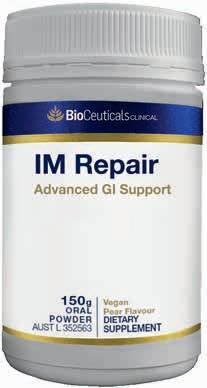
Only available after a consultation

REQUEST PRACTITIONER ACCESS FOR FREE
Follow the link/QR code to our registration page.


BROWSE THE BIOCEUTICALS CLINICAL RANGE.
www.bioceuticals.com.au/login/registration_practitioner www.bioceuticals.com.au/product/brand



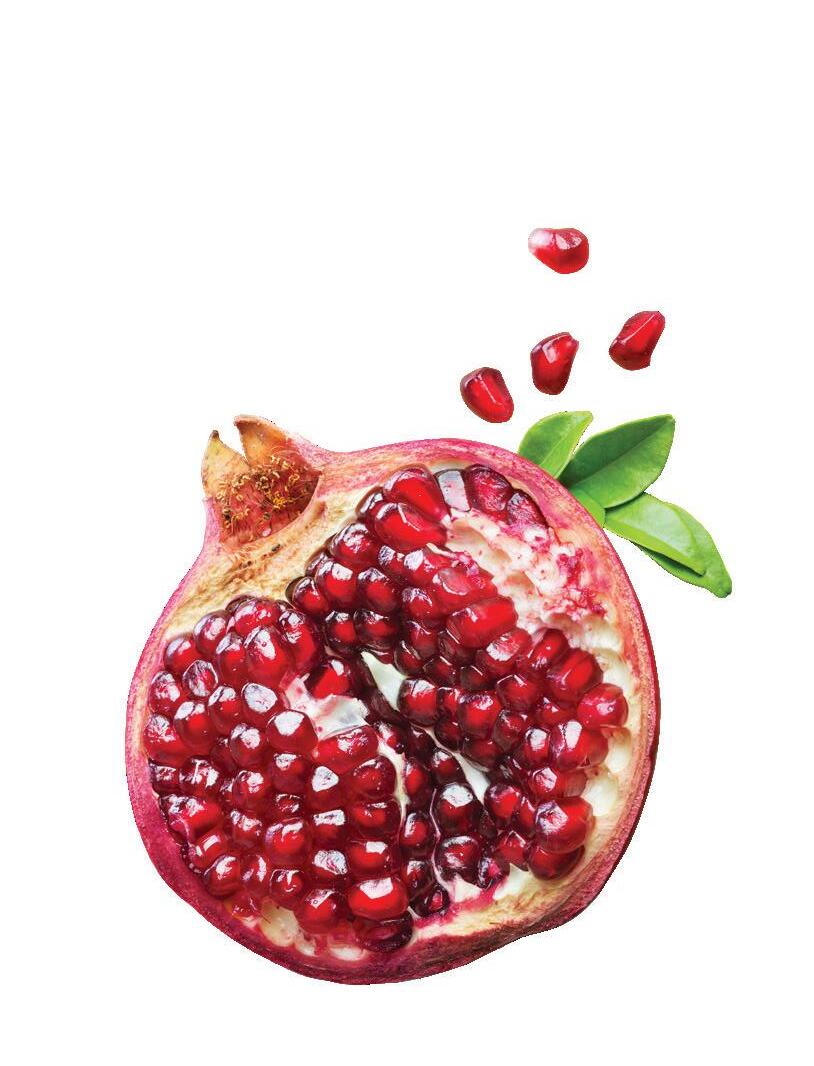




L-PHASE provides a unique combination of Chaste Tree, Paeonia and Chamomile in combination with selective nutrients aimed at supporting female reproductive health. Chamomile naturally contains apigenin, a phytoprogestin and has shown to support menstrual regularity.*
For practitioner dispensing only. Always read the label and follow the directions for use.
*References available upon request, contact Clinical Support.
OESTRO DETOX is a high-quality nutritional powder for daily supplementation. This comprehensive powder is specially formulated with Broccoli seed powder, Pomegranate, Turmeric, Rosemary, Green Tea and White Button Mushroom extracts.
Order now
13. Simple Strategies for Distance Running Injury Prevention
Isaac Enbom provides manual therapists with some simple strategies to keep your patients running injury free.
18. Harnessing The Power Of Nutritional Compounding
The act of ‘compounding’ simply refers to the making of ‘custom’ medicines, writes Warren Maginn.
26. Wellness tips for new graduates
Bronwyn Frazer writes to help new graduates navigate life after study.
28. Sour Cherries
Elise Cowley explores the surprising fruit for athletic performance and recovery.
35. Yoga Nidra
Bridging ancient Yogic wisdom with modern wellness, writes Neerja Ahuja.
Andrew Pengelly profiles the Sterculia quadrifida R. Br.
44. Chinese Medicine in the Management of Gastroparesis
Mark Shoring gives a summary review.

The Natural Therapist is published by the Australian Natural Therapists Association (ANTA) for natural therapy practitioners. The opinions and views expressed by the contributors and advertisers are not necessarily the opinions and views of ANTA. Every effort is taken to ensure accuracy and ANTA accepts no responsibility for omissions, errors or inaccuracies. ANTA relies on contributors and advertisers to make sure material provided for The Natural Therapist complies with the Australian Consumer Law under the Competition and Consumer Act 2010. ANTA accepts no responsibility for breaches of the Australian Consumer Law by contributors or advertisers. Material in The Natural Therapist is subject to copyright and may not be reproduced in any form without the permission of ANTA and its contributors.
Shaun Brewster
• National President
• Director of ANTA
• National Myotherapy Branch Chair
• ANTAB Chair
• ANRANT Committee Member
• Health Fund Chair
Warren Maginn
• National Vice-President
• Director of ANTA
• National Nutrition Branch Chair
• TGA Chair
• Ethics Panel Chair
• ANTAB Committee Member
• ANRANT Committee Member
Ananda Mahony
• National Treasurer
• Director of ANTA
• National Naturopathy Branch Chair
Kaitlin Edin
• Director of ANTA
• National Acupuncture Branch Chair
• ANTAB Committee Member
• ANRANT Committee Member
Isaac Enbom
• Director of ANTA
• National Remedial Therapy Branch Chair
• ANTAB Committee Member
• ANRANT Committee Member
Mark Shoring
• Director of ANTA
• National Multi-Modality Branch Chair
• ANTAB Committee Member
• ANRANT Committee Member
Tino D’Angelo
• Director of ANTA
• National Chinese Herbal Medicine Branch Chair
Neerja Ahuja
• Director of ANTA
• National Ayurveda Branch Chair
David Liesegang
• Executive Officer
• Company Secretary
• Business Plan Chair
• ANRANT Chair
Circulation Enquiries 1800 817 577
Editorial & Advertising Enquiries thenaturaltherapist@anta.com.au
Membership Enquiries info@anta.com.au
ANTA NATIONAL ADMINISTRATION OFFICE
T: 1800 817 577
F: (07) 5409 8200
E: info@anta.com.au
P: PO BOX 657 MAROOCHYDORE QLD 4558 W: www.anta.com.au
We are excited to launch our new look The Natural Therapist Journal! We want to bring you more engaging content and keep up to date with all the latest information across all modalities. This is the first of many changes here so please make sure you stay up to date with all ANTA news and Watch This Space!
You have spoken and we have listened to the difficulties with membership renewals occurring on the 31st December. We have now aligned all of our memberships across all modalities to renew on the 31st March. This is effective immediately and all members that were due for renewal on the 31st December 2024 have been given an additional 3 months Free Of Charge. Next ANTA Membership Renewal Date for all members will be 31st March 2025.
Are you a natural health professional that loves to write and share content? Or maybe speaking and presenting is where you shine?
Do you have an area of expertise in which other ANTA members would benefit from you sharing your knowledge?
As a valued ANTA member, we want to hear from you! Send us your recent content/programs or presentations to marketing@anta.com.au.
We are half way through the year so make sure you are on track gaining your 20 points of CPE for the year. This is a requirement for your ANTA membership and for Health Fund recognition. Continuing Professional Education is a great way to develop your knowledge and skills to ensure you provide the best possible care for your patients.
Remember 50% of your CPE hours must be related to the modalities you are accredited in by ANTA. Don’t forget we still have 2 seminars in Melbourne and Perth that are a great way to get your CPE points. Information about these seminars will be announced on our website.
Beyond Blue’s New Access for Small Business Owners is a free, guided self-help mental health coaching program, designed to support small business owners like you. With the demands of everyday life stressors including running a small business, supporting our own wellbeing as practitioners is essential.

To make an appointment or find out more, email newaccess.smallbusiness@rfq.com.au or visit the Beyond Blue Website for further information.
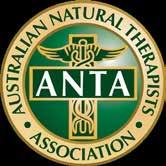




ANTA Chief Executive Officer, David Liesegang.
As the newly appointed CEO of the Australian Natural Therapists Association (ANTA), I am stepping into a role that is both a privilege and a responsibility. ANTA has long been a beacon for the natural therapy industry in Australia, setting the standards for excellence and integrity.
My vision is to build upon this foundation, steering our members and the industry towards a future where evidence-informed natural therapies are integral to the Australian healthcare system, recognised for their value and safety in enhancing health and wellbeing.
ANTA's dedication to upholding high professional standards and strict conduct criteria has rightfully positioned our members as leaders in the field of natural therapies. This recognition is not merely a badge of honour, it reflects the commitment of our members to providing safe, quality healthcare - as evidenced by the trust placed in us by over fifty health funds and WorkCover insurers.
As we look to the future, our focus will remain steadfast on advocating for the recognition and regulation of important natural therapy modalities. A key priority is the integration of suitable natural therapies into mainstream healthcare. This requires both showcasing the evidence-informed benefits of natural therapies and fostering collaborative relationships with conventional healthcare providers. As part of this endeavour, a clear goal of ANTA remains to achieve statutory regulation that not only distinguishes suitably-qualified practitioners but also ensures public trust and safety.
Our efforts will continue to be supported by our robust professional indemnity insurance offerings, specifically tailored for Australian natural therapists, which ensures ANTA members meet the legal requirements to be registered as providers with Australian private health funds.
To dispel misconceptions surrounding natural therapies, under my leadership, ANTA commits to engage in transparent communication, education, and outreach. Member growth and impact remain at the heart of our mission. And we remain steadfastly committed to further upholding rigorous educational standards to strengthen the scientific foundation of natural therapies and investing in high-quality research & innovation in natural therapies and practice.
Further, embracing technology is essential in today's healthcare landscape. Digital health innovations, including virtual health (telehealth) services and other digital health
platforms, offer genuine opportunities for natural therapists to expand access to care and enhance patient outcomes. ANTA is committed to supporting our members in adopting these technologies, and ensuring ANTA members remain at the cutting-edge of naturally-intelligent healthcare delivery to meet patient needs.
To this end, and in recognition that the challenges and opportunities facing natural therapists extend beyond Australia's borders, I am also committed to forging both local and international partnerships. By sharing best practices, ANTA aims to create both local and global ecosystems of natural therapy professionals, united in our mission to advance the profession and improve health outcomes.
Alongside a highly-qualified ANTA Board of Directors and our highly-professional ANTA administration team, my commitment to ANTA members is to, together, meaningfully enhance member engagement, navigate the complexities of the natural therapy landscape, champion the profession's value, and ensure ANTA plays a pivotal role in shaping the future of natural healthcare, across all of our modalities.
And in doing so, we will continue to do what ANTA has done best for the longest time as a multi-modal natural healthcare Association, for the past 70 years - meaning we will continue to require our ANTA members to strictly abide by ANTA’s Code of Professional Ethics, and especially to:
• Provide quality health care services consistent with qualifications and training
• Prioritise the safety, health and wellbeing of patients by treating them with compassion, respect and the highest degree of professionalism
• Listen to and address the concerns of patients, families, and carers, presenting information accurately and clearly
• Respect patients' rights to make decisions about their healthcare and refer them to other health service practitioners as appropriate
• Enhance their education to maintain currency of healthcare services
• Enhance their professional reputation through safe and hygienic practice environments, as well as accurate and secure patient records.
The path ahead is filled with potential. And I am honoured to lead this industry-leading Association into an exciting new era, and to engendering a sense of belonging for all natural therapists throughout the Country who truly aspire to succeed and to make a real difference in their fields.
























Over 60 years ago, the Pharmacy Guild of Australia launched Guild Insurance – designed to protect and safeguard the pharmacy profession. Since then Guild has expanded the network of professionals we protect by forming partnerships with associations who represent a wide range of industries and the professionals who work within these fields.
Proudly partnering with the Australian Natural Therapists Association for over 4 years means we understand the importance of protecting you with more than just a policy.
With us, you’ll be shielded by a policy created from unmatched insight into your profession, access to risk management materials to help you reduce the risk of a claim, backing
from the industry body that stands up for Australian natural therapists, and so much more.
Find out how you can be part of something bigger by visiting: guildne.ws/ANTA or calling 1800 810 213 today.

Written by Isaac Enbom.
It’s that time of year again when a lot of our patients pound the pavement in an attempt to return to normality or to achieve a new year’s goal. Often the increase or change in running habits results in injury. This article attempts to provide manual therapists with some simple strategies to keep your patients running injury free.

Most running related injuries are a result of musculoskeletal overload which is commonly caused by poor training habits. It’s important that runners understand appropriate training volumes and good recovery strategies. However, this is difficult to achieve without a running coach or a professionally tailored running program. Most distance runners will measure their training progress by distance (kilometres), duration (minutes) and / or speed (minutes per kilometre). All of these are now very easy to measure with the use of technology such as smart watches or apps for example. These metrics can become an obsession with runners which can lead to over-training, cumulative stress and ultimately, a running related injury.
So, what is an appropriate amount of training volume and what sort of training principles should runners take into consideration?
Historically, runners have considered distance, duration, or speed to be the measure of success. Relying on these metrics alone can significantly underestimate the total training stress that is applied, especially if it is applied repetitively over time. Focussing solely on these ‘External Training Loads’ fails to take into consideration how runners ‘feel’ during a given training session, which is not only influenced by distance or duration but also by the runner’s state of recovery and daily stress (e.g. sleep, illness, relationships etc.)1
Clinical commentary by Paquette et al. (2020)1 describes training loads in two categories:
• External Training Load – the mechanical load such as distance or duration, and
• Internal Training Load – the physiological and psychological responses to the external load such as rate of perceived exertion, heart rate and blood lactate levels.
External Training Load is easy to quantify but Internal training load is more difficult without the use of sophisticated equipment. The easiest way to measure Internal Training Load is to use a session Rating of Perceived Exertion (sRPE) on a numerical scale of 1-10, similar to that of the Visual Analogue Scale (VAS) commonly used to assess pain. The sRPE has been found to correlate well with blood lactate threshold which further validates its use2
Manual therapists should encourage runners to be mindful of their total training loads. A study by Napier et al. (2020)3 examined a combination of External and Internal Training Loads to determine individual training responses. The study found this method provided a more accurate representation of total training load as well as a more individualised estimate of week-to-week changes in training stress. This can have significant implications for
monitoring training adaptations, resulting performance and possibly injury prevention.
The method combined session running duration (minutes) multiplied by the sRPE (1-10) which resulted in the session training load. This value is then monitored and compared to previous session loads over time. For example, during a typical training week, a runner might document the following:
Run 1: Duration: 60 mins
sRPE: 3/10 (relatively easy)
Training load = 60 x 3 = 180
Run 2: Duration: 70 mins
sRPE: 5/10 (moderate exertion)
Training load = 70 x 5 = 350
Run 3 Duration: 45 mins
sRPE: 7/10 (difficult)
Training load = 45 x 7 = 315
Total weekly training load = 180 + 350 + 315 = 845
This weekly load value can then be monitored over time with attention to any major or progressive increases beyond
a couple of weeks. This simple method of monitoring the training load could be a useful predictor of injury. However, running related injuries are multi-factorial. Other training factors such as frequency, surface, type (i.e., track, hills etc.) and recovery strategies should be considered in how they can contribute to injury.
As manual therapists, we have a responsibility to investigate and implement injury prevention strategies with our clients where possible. The simple act of runners paying attention to their Internal Training Loads and monitoring their total weekly training load over time using these methods could be a useful predictor of injury. In addition, it can be an easy method to help runners self-quantify and adjust their optimal weekly training volume. The methods should be practiced over time taking into consideration the individual goals and training tolerances. The crucial step is for runners to think outside distance or duration and to be more mindful of how their body is feeling and adapting to training. Thinking about the total training strategy can lead to more efficient training, less cumulative stress and reduce the risk of injury.
For references log into your ANTA Member Centre > The Natural Therapist > Journal Articles.


Utilising an evidence informed and interactive learning approach with pre-course online modules, combined with face-to-face practical training, and post-course supportive materials, all designed to help you become the best practitioner you can be.
Dry Needling course
Refresher Dry Needling course
Advanced Dry Needling course
Hip and Pelvis Dry Needling course





Podiatry
Hand
Dental


By combining traditional botanical knowledge with contemporary scientific understanding, Ayurvedic medicine remains relevant in the modern world. Researchers are continuing to explore the potential benefits of Ayurvedic herbs, practices and treatments for a wide range of health conditions, leading to better understanding and integration with contemporary medicine.
• Ayurvedic remedies have been used extensively for millennia.
• Today’s Ayurvedic formulas are a culmination of practical experience and direct observation, with continual advancement and evidence-based insights.
• Ayurveda use holistic treatment approaches individualised to the patient.
• Ayurvedic remedies may be used exclusively or combined with modern medicine as part of management of health conditions.
Asafoetida | Black Salt | Carom Seeds
Helps reduce the occurrence of medically diagnosed irritable bowel syndrome (IBS) symptoms including:
• Bloating, abdominal pain, flatulence (cramping and spasms)
Traditionally used in Ayurvedic Medicine for anaha hara to help:
• Relieve the symptoms of abdominal bloating and distention
• Reduce flatulence and associated pain

Liquorice | Malabar Nut | Holy Basil
Cardamom | Ginger | Black Pepper
Traditionally used in Western herbal medicine:
• As a cough suppressant
Traditionally used in Ayurvedic medicine to help:
• Loosen chest phlegm
• Reduce excess chest phlegm

Galangal | Indian Frankincense | Ginger Ashwagandha | Turmeric
Helps support inflammatory conditions of joints and muscles
Traditionally used in Ayurvedic medicine for shotha hara and in Western herbal medicine to:
• Reduce mild joint inflammation and swelling
• Decrease mild joint pain and soreness

Malabar Nut | Liquorice | Holy Basil | Albizia lebbeck | Cinnamon | Black Pepper
Traditionally used in Western herbal medicine:
• As a cough suppressant
Traditionally used in Ayurvedic medicine:
• To help relieve a dry, unproductive cough


Written by Warren Maginn.
Most natural medicine healthcare practitioners have heard the term ‘compounding’, however a surprisingly large number of practitioners still remain relatively unfamiliar with its true nature, how it can be (and/or should be) performed, and ultimately its power to transform their practice.
Some reasons for this may include uncertainties around what is allowed under current Australian regulations, how best to navigate some of the technical complexities involved, and the currently relatively limited level of training available (including within various natural medicine college courses).
It therefore continues to be of benefit, to both experienced practitioners as well as new students alike, to revisit and explore the topic of compounding. The following overview is intended to serve as a summary of the key concepts involved, as well as some of the main requirements, techniques and tools available, to assist more practitioners to build their confidence with this powerful and important aspect of personalised medicine.
Quite simply the act of ‘compounding’ simply refers to the making of ‘custom’ medicines (as opposed to those that are mass manufactured for commercial sale in stores). Even though the term ‘compounding’ does imply the combining of ingredients, it is important to note that this is not compulsory (i.e. the dispensing of a single ingredient as a medicine on its own still constitutes a form of compounding).
Therefore, a compounded medicine may be comprised of multiple ingredients, or a single ingredient, and may come in any number of ‘dosage forms’ e.g. liquids, creams, and of course… powders.
Some of the benefits of choosing powders as the primary dosage form to use (especially in the case of Nutritional
Compounding) include:
• They are stable (when free from moisture)
• They avoid the need for many additives (stabilisers, preservatives, antioxidants, etc.)
• They are easy to blend (create an even mixture)
• They are easy to dose (deliver predictable quantities)
• Most nutrient/nutraceutical ingredients are produced in powder form
• They can free us from the mortar and pestle!
Despite the above benefits of using pre-powdered ingredients, the somewhat cliché imagery of a mortar and pestle often continues to be used when illustrating the practice of compounding. This is primarily a nod to past medical traditions that involved manually breaking down raw ingredients into powder form prior to use for ease of mixing, rather than a literal representation of what is actually involved in the practice of modern compounding. Historically, it could be said that compounding has been performed since the dawn of medicine. It can also be said that modern pharmaceutical medicine derives much of its origins from related ancient herbal medicine practices. Due to this strong historical heritage, modern Western Herbal Medicine has continued the tradition of custom compounded medicines, most typically in Australia in the form of liquid tinctures.
The reasons perhaps why custom Nutritional Compounding has been somewhat less familiar to some practitioners relates to the relatively more historically recent discovery and synthesis of isolated pure nutrients and nutraceuticals, their clinical benefits, and how to use them.
In this sense, natural medicine practitioners who are able to update their understanding of Nutritional Medicine to include the production of custom nutritional medicines (through Nutritional Compounding) as a fundamental practice, follow in much the same heritage as the Herbal Medicine practitioners of yesteryear who contributed to the currently ubiquitous understanding and practice of personalised herbal medicines.
The dispensing of pharmaceutical (S3 and S4) ingredients are restricted to medical doctors and pharmacists (e.g. Compounding Pharmacies) in Australia, for obvious reasons related to their specialist qualifications and areas of training and expertise.
The dispensing of natural medicine ingredients (such as amino acids, vitamins, minerals, botanicals, nutraceuticals, etc.) are restricted to healthcare practitioners that are sufficiently trained and qualified in an ingestive modality (such as Clinical Nutritionists, Herbalists and Naturopaths), as accredited by a professional association (such as those recognised by Australia’s Therapeutic Goods Administration (TGA), including ANTA).
This means that the practice of compounding is restricted to qualified healthcare professionals only, and the ingredients allowed to be used are limited by qualifications, scope of practice, and various other regulatory controls.
However, this also means that numerous (non-TGA) ingredients which are not currently available to be used in mass-produced commercial supplement products in Australia, can in fact be used by Australian natural medicine practitioners when making their own custom medicines. Which may, therefore, present an opportunity to access powerful therapeutic ingredients that would otherwise be unobtainable to a given patient who could benefit from them.
Some of the regulatory requirements of this exclusive practitioner privilege include that a compounded medicine must be:
• Made for an individual person (not mass-produced)
• After private consultation with the patient (at the time it will be dispensed)
• Made on the premises (they will be dispensed from)
• By a suitably qualified professional (using their own knowledge and judgement)
• Appropriately sourced, assembled, documented, and labelled.
The appropriate ‘sourcing’ of ingredients to use within compounding requires that:
• For products/ingredients that are not registered with the TGA:
Only use pure single ingredients (no premixes, no excipients – otherwise they would need to be listed with the TGA)
• When using ‘pre-mixed’ commercial formulas: Only
use TGA registered products (otherwise they would breach the on-premises provisions)
• Only use ingredients permitted by all national regulations (e.g. TGA, agricultural, etc.)
• Within scope of practice (according to training and qualifications)
• Accurately identified (knowing precisely what is being sourced).
The process usually begins with the initial clinical evaluation of a patient’s needs, e.g. via a thorough case history and investigations. Which may sometimes include laboratory testing to gain insights into unique metabolic processes (such as hormone levels, nutrient levels, toxin levels, etc.). After considering which substances and nutrients may be most beneficial to the patient in their current circumstances, some specific ingredient forms and their quantities need to be decided.
Once these desirable ingredients and their quantities have been decided, the process of assembling the medicine can begin (usually immediately after the consultation).
Note: The responsibility for any decisions related to doses and quantities remains exclusively with the prescribing practitioner (this key responsibility should not be delegated to staff or external resources without confirmation by the responsible practitioner).
The ‘appropriate assembly’ of a compounded medicine includes a number of requirements that should be kept in mind, practiced, and planned for, whenever carrying out compounding in clinical practice.
The following sequence outlines the key steps involved:
Note: All key stages of the assembly of a compounded medicine should be carried out by the suitably qualified/ trained practitioner/s in a clinic. Any unqualified staff (such as reception staff) need to be supervised by a practitioner in order for them to participate in assembly steps.
Step 1: Calculate the amounts of ingredient needed to deliver the desired daily dose, divided by the number of doses per day, for the number of days the prescription should be taken (which will help determine the total amount of ingredient required).
Step 2: Each intended ingredient should be correctly identified and gathered (e.g. via clear bulk container labelling) and checks for expiry dates (to the end of the intended prescription).
Step 3: The intended total quantity of each ingredient required to achieve the overall formula should be accurately measured (using well-calibrated high-precision scales).

Step 4: If using more than one ingredient, all measured ingredient quantities need to be blended (through the thorough rotation/shaking of a sufficiently spacious container to create an even mixture).
Step 5: The ingredient/mixture then needs to be poured into a suitable container and sealed, to be dispensed to the patient (along with a suitably sized scoop and some instructions to assist accurate dosing).
Maintaining ‘appropriate documentation’ i.e. for giving to the patient as well as for keeping on file within practitioner clinical records, is particularly important when dispensing medicines and should include at least the following:
• Full patient details (especially Name, Date of Birth, contact details)
• Full formula details (all substances and input quantities used)
• Full dosing instructions (when, how much, how often, for how long)
• Other advice and rationale (why, what for).
Ensuring that ‘appropriate labelling’ is provided with all medicines being dispensed is one of the most important requirements of all, and given the overlap with many of the same items of information described in the above documentation requirements, it may be most efficient for practitioners to simply provide their patient prescription information on the label at the same time.
Practitioners should ensure their medicine labels include:
• Secure attachment to the dispensed container
• Patient Identifiers (at least Name and Date of Birth)
• Prescriber/Dispenser Identifiers (Name, Contact details, Modality/Qualifications)
• The names and quantities of all active ingredients (e.g. mg per dose)
• The Dosing Unit (e.g. scoop size)
• How many of the dosing units to take (to achieve a Single Dose)
• The Dosing Frequency (e.g. how many doses per day)
• Instructions for Use (e.g. with/without food, at certain times of day, etc.)
• Expiry/Duration of Supply (how long to take before renewal is required)
• The Total Quantity of medicine being supplied.
It is one of the most fundamental tenets of natural and holistic medicine to ‘treat the individual rather than the disease’. Compounding therefore provides one of the most profoundly individualistic ways to approach clinical treatment.
Getting access to certain powerful active ingredients that would be highly beneficial but otherwise unavailable to use in a prescription for a given patient, as well as ensuring that a medicine delivers all that it should and nothing it shouldn’t (e.g. avoiding unnecessary ingredients and even potentially obstructive excipients), often yields better compliance and better clinical outcomes.
The value of a medicine can be gauged in a number of ways, not least of which its potential to yield potent improvements to the clinical outcomes described above. However compounded medicines are often able to achieve this whilst also being more cost effective (through reduced overall cost and/or higher delivery of key ingredients).
Furthermore, the value to practitioners can include creating some exclusivity for their patient, which can in turn build their rapport and engagement with their treatment. This, along with compliance, are often critical to achieving long term clinical success, and long-term success is particularly important within natural medicine practice, given how
many natural medicine goals seek to address long term chronic health risks and processes.
It could therefore be said that compounding may be key to the success of certain modalities, and overcome some of the over commercialisation of industry prescribing practices.
The next steps for any practitioner who has not yet tried making custom formulas, is simply to begin. Thankfully there are now numerous ranges of compounding ingredients in Australia that are specifically provided for natural medicine practitioners to use in their practice, along with some of the further equipment and guidance required. For an example formula sheet, practitioners may wish to view a manual compounding template online here: wmed. link/manualsheet
Once the basics have been mastered (for example the dispensing of a single ingredient, and establishing accurate in-clinic compounding processes), practitioners may then wish to seek out further tools and resources to make the process easier and more efficient (e.g. through automation), as well as potentially more advanced and complex (e.g. for those particularly difficult cases that require a practitioner with the care and attention to detail to go the extra mile). For more tools and resources intended to help practitioners to implement compounding and personalised medicines into their practice go to warrenmaginn.com.
Happy Compounding.










Backed by 25 clinical trials in a range of conditions from mild migraine relief to muscle cramps
PREMIUM QUALITY
Free from sulfites & produced with the highest manufacturing standards
OPTIMAL BIOAVAILABILITY
Proven bioavailability and fast delivery
HIGH STRENGTH MAGNESIUM 400
For peak absorption, fast and




Alkalising mineral citrates for optimal pH balance backed by clinical trials
PREMIUM QUALITY
Produced in accordance with the highest manufacturing standards
OPTIMAL PH
Restores pH at the body systems, tissues and cellular levels
SUITABLE FOR SENSITIVE PATIENTS
Bicarbonate & sulfite free formula does not disturb digestive processes


A woman’s health is impacted by her microbial system in many significant ways.
Microorganisms are found in niches all over the body, including the gut and the vagina, and these communities behave just like functional organ systems. Their biochemical interactions and integration with human physiology means we always need to be considering the status of our microbiome for optimal health.
The microbiome can be implicated in a number of common health concerns facing women across their lifespan, including:
• Iron status and refractory iron deficiency
• Vaginal dysbiosis and recurrent infections
• Fertility and pregnancy outcomes
• Bone density loss
Activated Probiotics has a range of condition-specific probiotics that target various aspects of women’s health across the lifespan, including:

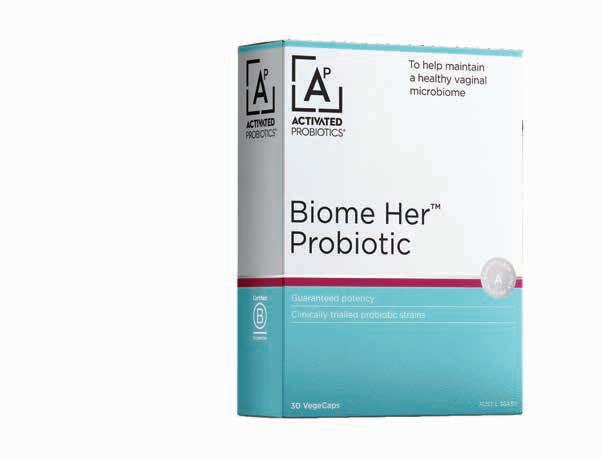
Clinically-trialled formulation to help increase absorption of dietary iron
AUST L 315955


Clinically-trialled probiotic strains to help maintain a healthy vaginal microbiome
AUST L 364311


Nutrients and clinicallytrialled probiotic strains to help support a healthy pregnancy
AUST L 316500

Clinically-trialled probiotic strains to help support healthy bone density in adults
AUST L 315633

Written by Bronwyn Frazer.
When you decide to study a natural health degree or diploma, you make a heart and mind commitment to use your talents to help others. But over time studying can take a toll on your health, emotions, finances, and relationships. By the time you finish, you might not be in great condition.
This article has been written to help new graduates navigate life after study.
When I first enrolled in my Nutrition degree, I thought I would easily ‘knock it out’ in three years (full time), whilst juggling corporate work and other commitments.
But life continued to prove me wrong.
Due to unplanned changes, including the death of my beautiful dad and arrival of the pandemic, it took me four and half years to complete it. By the time I was finished studying, I was tired on multiple levels.
If you resonate with this, I encourage you to allow yourself the time to rest, recharge and heal before you launch a business or look for work. The world needs you to be whole and healed before you can fully step into your new career.
Tip: Don’t feel guilty or bad about taking time off between studying and starting your next thing. It’s ok to hit pause and take time out for you.
When you finish studying, don’t be surprised if you feel some unexpected emotions. My immediate emotion was relief that I had finished and survived, despite all the challenges I faced. But this was quickly followed by sadness and unrepressed grief about perceived losses.
I missed my beautiful dad who was no longer around to cheer me on or congratulate me when I finished. I also felt sad about the friendships that had ended because we no longer had enough in common. And I felt sad about losing my former identity as a successful businessperson and the income that went with it.
Then I realised I felt a tad angry at myself that through choosing to study another degree my finances were flatlined and now I had a big HECS debt.
Another interesting emotion was the waves of loneliness that came and went. I couldn’t talk to my friends or family about health topics they didn’t understand or (to be honest) care about. And I really missed talking to the other students in class about health facts and the uniqueness of client cases.
It took a few weeks to clear the mix of emotions, but through taking good care of myself I was able to deal with and clear each layer. I recognised that this too was part of my personal growth.
Tip: Feeling a mix of emotions is natural and normal. Give yourself permission to recognise and feel the emotions, as they arise. If you need help clearing the energy, seek help from a natural therapist or counsellor.
After finishing your course, you may feel burnt out and potentially ‘wired but tired’. You may even lack passion and purpose for what you even studied. If this describes you, please take time to rest and recharge in the ways that best suit and support you. Because you cannot help others and be fully present to support clients if you are not in a great shape yourself.
Once I finished studying it took me a while to wind down. I was still working in a corporate role, so it was easy to focus purely on that work. But I was super tired, despite now working four days instead of a six-day week which I’d been doing for more than a year.
So, when the waves of exhaustion hit I knew that I needed to rest and recharge. I booked a massage, had reflexology, and took a range of Australian Bush Flower essences. I also made sure that I had a nature walk every day for at least 30 minutes. Everything combined supported me through yet another transition. After three months, I felt like I was me again.
Tip: Make time for you because you cannot help others if you are not well yourself. Find ways to return to balance.
Finally, you need to celebrate the fact that you have finished studying.
After my last subject, a group of students and I went out for lunch. This helped us all debrief and have a team drink and say goodbye. I also booked quality time with people I hadn’t been able to catch up with, due to study and work commitments. I updated my social media sites so that people knew I’d achieved what I set out to do. Accepting praise took me a while to get used to, but it was important for my Soul.
Tip: You’ve proved to yourself that you are strong, brave, and resilient. Now it’s time to give others an opportunity to recognise and celebrate your achievements.
Bronwyn Frazer is a communications specialist, writer, freelance journalist, and Clinical Nutritionist who has a passion for natural health. She is trained in reiki, crystal therapy and the Australian Bush Flower essences, and is drawn to ancient healing wisdom including Ayurvedic Medicine.
To book a holistic nutrition and wellness consult with Bronwyn, visit www.bronwynfrazer.com.au
@bronwynfrazerwellness
@brownynfrazer.wellness

Written by Elise Cowley.
Sour cherries have long been lauded for their delicious tartness and are highly regarded as a valuable therapeutic food in the fields of naturopathy and nutrition. But does the research support the claims that we as natural health practitioners espouse? Aside from their tangy taste and vibrant purple hues, sour cherries possess some surprising health benefits that are worth acknowledging. Let's look at the available evidence on sour cherries in exercise recovery and elite performance.
Cherries derive their name from the Old Northern French or Norman word 'cherise', and the Latin word 'cerasum'. Around two dozen widely known species of True cherries exist, including the globally popular Prunus Avium (sweet cherry), Prunus Cerasus (sour cherry), Prunus Emarginata (Oregon or bitter cherry) and Prunus Pennsylvania (fire cherry). Some of the earliest evidence of cherry cultivation dates before 72 BC in the Anatolia regions of Türkiye and the Northern Mediterranean.
It takes approximately 4 years for a newly planted cherry tree to yield its first harvest of fruit. Cherry flowers are known for their soft pink, white or red flowers that bloom from a single bud. In Japan, the stunning beauty of cherry blossoms can be experienced during the Spring season, when Sakura trees from Okinawa to Hokkaido bloom in astonishing numbers. Here in Australia, cherries are typically in season during late December and are a beloved treat during the Christmas holidays.
The variety of cherries that we commonly refer to as "everyday cherries" is called Prunus Avium or sweet cherry. Closely followed in popularity is the Prunus Cerasus or sour cherry variety, which boasts most of the health benefits we see in clinical practice. Sour cherry and tart cherry are terms used interchangeably to denote the
same thing. As such, this subspecies appears in much of the scientific research for various conditions. Both have origins in Europe and Western Asia.
• Anthocyanin-rich with antioxidant properties
• High in vitamin C and beta-carotene
• Lowers oxidative stress and inflammation
• Reduces exercise-induced muscle soreness and fatigue
• Improves pain threshold and muscle flexibility
Cherries possess some impressive metabolic and anti-inflammatory properties, chiefly due to the high anthocyanin content. Sour cherry is well-known for its capacity to reduce oxidative stress, enhance sleep and improve cognitive function. Many researchers, therefore, have sought to illuminate the benefits of sour cherry juice and cherry concentrate on athletic recovery and performance. When it comes to exercise recovery, it seems that tart cherries demonstrate some conflicting, yet promising efficacy.
The existing literature on tart/sour cherry juice has earned this little fruit a position as a 'Group B' supplement, listed by the Australian Institute of Sport Supplement Classification System. This means there's plenty of incentive to propel the research on sour cherry, as it has strong potential benefits for elite and emerging athletes in Australia.
Let's review some of the existing trials and analyses conducted on sour cherries.

A French study evaluated the effects of tart cherry (prunus cerasus) on functional performance in a group of high-intensity cyclists. In this small trial, 30ml of cherry concentrate was administered two times a day for 8 days. On the 8th day, the cyclists completed a 109-minute cycling trial. Blood samples were taken pre- and postevent, as well as during several intervals within 72hrs. The results showed marked reductions in several inflammatory markers, including IL-1ß, IL-6, IL-8, tumour necrosis factoralpha and high-sensitivity CRP. These findings correlated directly with better functional performance as well as a reduction in delayed onset muscle soreness (DOMS) and fatigue. Consuming cherry concentrate after a rigorous cycling session can contribute to accelerated recovery and a reduction in inflammation following exercise.
Similar to the above study, another trial published in the European Journal of Sport Science examined the same cherry intervention in a group of active female study participants. Various measurements of muscle soreness, pain threshold, flexibility and inflammation were taken throughout the study. The results showed a reduction in inflammation, better jump height, lower muscle soreness and higher pain thresholds were all observed in this group of female athletes due to the inclusion of sour cherry concentrate.
In contrast, a 2020 study published in the International Journal of Sports Physiology and Performance examined the effects of tart cherry juice on a group of professional soccer players. Reserve players from an English Premier League club consumed 30mls of tart cherry juice, once before and once after their 90-minute game. A final two serves of cherry juice were administered 12 and 36 hours later. Muscle function and muscle soreness were measured at various intervals. There were some self-reported

improvements in muscle function and reactive strength indices. However, there were no statistically significant benefits on team recovery from sour cherry juice.
Interestingly, sour cherry showed minimal overall benefits in a group of elite Water Polo players. Nine male Water Polo athletes took part in a study where they were given either cherry juice or a placebo equivalent for six days in a randomised, double-blind, repeated measures, crossover design. The athletes underwent water-based performance testing before and after the supplementation period. Blood samples were taken on days 1, 6 and 7 to measure inflammation and oxidative stress. The results showed no differences in performance or recovery measures following cherry juice consumption. Researchers propose that the reason for this is because water polo is a less strenuous, non-weight-bearing sport and as such may not elicit a significant inflammatory response that is seen in other disciplines.
In the nutritional sports medicine field, the overall consensus for sour cherry is positive as a therapeutic agent in athletic performance. The current body of evidence on sour cherry is elucidated in two recent papers that examined 24 studies in total. The 2020 meta-analysis and a 2021 systematic review, indicate that sour cherry supplementation is ideal for exercise recovery specifically related to strenuous or endurance-style exercise.
For athletes who undergo high-intensity training, activities that require load-bearing and maximal fatigue, it appears sour cherry is incredibly beneficial. Improvements in muscle soreness, inflammation, strength, maximal power, jump height and sprint time and global performance are all observed due to the therapeutic properties of sour cherry.
For references log into your ANTA Member Centre > The Natural Therapist > Journal Articles.

Attracts 10 CPE points
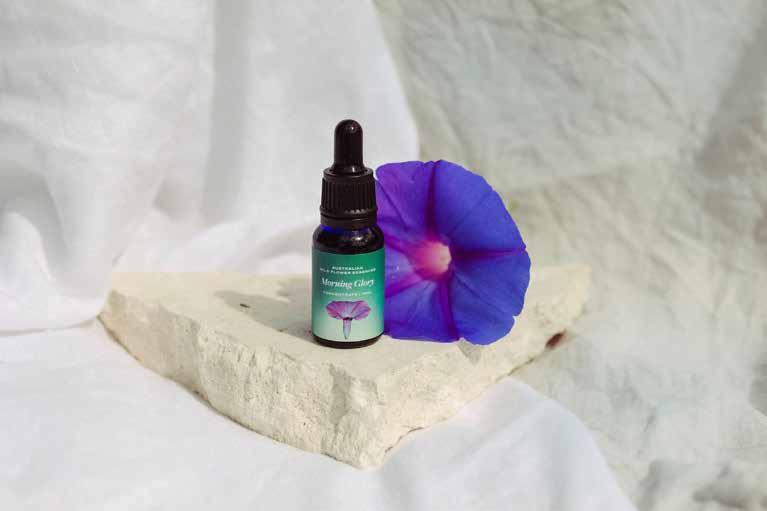
Deeply explore HeartRadiance Flower Essence therapy to enhance your practice with the help of expert lecturer and founder, Annie Meredith.

Annie is a multidisciplinary healer, acupuncturist and Traditional Chinese Medicine practitioner with over 40 years of experience.

Enhance your patients health & healing outcomes.
Discover diagnostic tools to help determine emotional and energetic patterns. Gain deeper knowledge in patient prescribing. Be guided through case studies.
This engaging and forward-thinking online course can help you start making flower essences immediately.

Level 1 Student Discount available on flower essence Kits

Visit the website for more details on the Level 1 Student Discount
heartradianceaustralia.com instagram.com/heartradiance
Threonine
Glutamine
Hydrolysed Collagen
Polaprezinc
Colecalciferol
Hesperidin






Written by Neerja Ahuja.
Yoga Nidra, often referred to as "yogic sleep," is a powerful and ancient yoga practice that combines elements of meditation, relaxation, and mindfulness.
Yoga Nidra practice goes beyond the conventional boundaries of relaxation. As part of centuries-old Indian traditions, Yoga Nidra is a profound path to conscious relaxation, meditation, and mindfulness. It takes you to a state between wakefulness and sleep, inducing deep physical, mental, and emotional relaxation, providing a holistic remedy for stress reduction.
Unlike traditional meditation, where the focus is on awareness and concentration, Yoga Nidra guides
practitioners to a state of conscious awareness while in a fully relaxed position. It is a state between wakefulness and sleep, where the body is in deep rest, yet the mind remains alert.
Originating from ancient yogic traditions, Yoga Nidra has been refined over time to become a structured and accessible practice, often used as a guided meditation and relaxation technique.

The practice begins with an awareness through the physical body, bringing attention to each part, and with conscious breathing and visualisation techniques used to guide practitioners toward a deep state of relaxation. During a Yoga Nidra session, you'll be lying down in a comfortable position, closing your eyes, and following the verbal instructions in the soothing voice of a guide. The practice involves systematic body scanning, breath awareness, and guided imagery, all leading to a profound sense of relaxation. The goal is not to fall asleep but rather to maintain a state of relaxed consciousness. The concept of Sankalpa is the intentional seed planted during Yoga Nidra. Crafting and repeating specific positive intentions influence the subconscious mind, shaping personal and professional growth.
Studies indicate positive effects on stress reduction, anxiety management and enhanced cognitive function. In one research study to assess the effects of a Yoga Nidra on life stress and self-esteem in university students, forty university students were selected by convenience sampling, with 20 assigned to a Yoga Nidra group and 20 to a control group. The yoga group participated in biweekly, 1 hour sessions of Yoga Nidra for 8 weeks. Life stress intensity level was measured using a 10 cm “Visual Analog Scale”, an accepted and reliable method measuring an individual’s perceived stress Self-esteem score was measured using Rosenberg's Self-Esteem Scale, a 10 item scale which is one of the most widely used psychological measures of self-esteem in adult populations
The Yoga Nidra group showed significantly decreased life stress intensity levels compared to the control group. The yoga group also showed significantly increased selfesteem scores compared to the control group.
These findings indicate that Yoga Nidra could alleviate or reduce the life stress intensity level and increase selfesteem in university students.
Stress Reduction and Mental Clarity
• Cortisol Regulation:
Yoga Nidra has been linked to the regulation of cortisol, a stress hormone. Reduced cortisol levels contribute to a calmer and more resilient mindset.
• Tension Release:
The practice involves systematic relaxation of different body parts, releasing physical tension and promoting a sense of ease.
Improved Sleep Quality
Quality sleep is foundational to overall well-being. Yoga Nidra's capacity to induce relaxation makes it a powerful tool for improving sleep quality. Individuals facing sleeprelated challenges, such as insomnia or disrupted sleep patterns, can benefit significantly from incorporating Yoga Nidra into their routine to promote a more consistent sleep cycle.
Yoga Nidra sessions designed specifically for sleep guide individuals into a state conducive to restful and rejuvenating sleep.
Enhanced Emotional Resilience
Emotional resilience is crucial in navigating the challenges of the modern life, be it home or workplace. Yoga Nidra cultivates emotional resilience by encouraging a nonreactive awareness of thoughts and emotions.
Observation without Attachment
Yoga Nidra teaches individuals to observe their emotions without becoming entangled in them, fostering a balanced and resilient emotional state.
Positive Outlook
Regular practice contributes to an improved mood, increased emotional stability, and an enhanced ability to respond positively to challenges.
Mindfulness and Concentration
The practice of mindfulness in Yoga Nidra contributes to heightened concentration through guided attention and breath awareness. It brings positive impact on a person’s ability to stay present, engaged, and productive.
In the peaceful state between wakefulness and sleep, Yoga Nidra can be a powerful tool in our quest for wellbeing. By weaving ancient yogic wisdom with modern practices, this intentional journey through breath and visualisation offers a profound way to reduce stress, boost cognitive function, and connect with our inner selves.
Yoga Nidra thus offers a range of benefits, including stress reduction, improved sleep quality, enhanced emotional resilience, and increased productivity. We can also use it for supporting any illness by creating specific Sankalpa. More than just a relaxation technique, Yoga Nidra supports inner awakening and a more balanced and resilient life.
Stay tuned for an upcoming Yoga Nidra ANTA Webinar in 2024 during which we will provide ANTA members with a guided practise of the technique to experience these benefits for themselves. Should this be of interest, please register your interest via marketing@anta.com.au.
synergistic herbal formula to relieve pain and inflammation

BioMedica Nutraceuticals P 1300 884 702 | www.biomedica.com.au

holy basil and magnesium blend with cofactors for a healthy stress response








With TrueBroc® Broccoli Seed Extract, Organic Chlorella and Milk Thistle
Highly concentrated powder with herbs and nutrients that help support liver detoxi cation.
Contains TrueBroc® allerolhc cinagro dna tcartxe iloccorb
Contains Sunphenon® green tea extract and Lipisperse® Quercetin CWD 90 for antioxidant support.
Includes milk thistle extract, traditionally used in Western herbal medicine to support liver detoxi cation and function.


bioclinicnaturals.com.au













Berberine, Curcumin, Bergamot, and Quercetin are nutrients with a broad spectrum of well-known clinical benefits. The bioavailability of these botanical extracts, however, can be variable and insufficient.
Utilising Indena’s Phytosome® technology, we’re able to optimise the bioavailability of these essential ingredients. Phytosome® represents a milestone in the natural healthcare industry by unlocking the full therapeutic potential of botanical compounds.
Experience the clinical advantages of Phytosome® technology for your patients with the RN Labs Phytosome® range.

29 x BETTER ABSORBED 10 x BETTER ABSORBED
20 x BETTER ABSORBED
2.5 x BETTER ABSORBED


Sterculia quadrifida R. Br.
Family: Malvaceae (prev. Sterculiaceae)
Common names: Peanut Tree, Red-fruited kurrajong, Faloak (Indonesia)
Written Andrew Pengelly ND, DBM, PhD.
The Peanut Tree can be found growing in the suburbs of Brisbane, and along the banks of the Brisbane River. Aware that the Peanut Trees’ distinctive seeds are edible, I searched the literature and found some well-documented traditional uses from both Australia and Indonesia, while noting the species has been the subject of numerous research papers focused on medicinal applications.
First a note on the taxonomy. As one of the common
names suggests this tree is related to the more wellknown kurrajongs (Brachychiton spp.) found throughout eastern and northern Australia. Both plants were once classified in the Sterculiaceae family, notable as containing the cacao tree (Theobroma cacao), the source of cocoa and chocolate. One distinguishing feature of the Sterculiaceae family is the follicular fruit, which splits down one side of a single carpel when ripe. In other Malvaceae such as Hibiscus spp., the fruit is a capsule, splitting open to reveal several carpels. A more technical difference is found in the anthers having two cells, while in other Malvaceae they have a single cell1

Sterculia quadrifida is a tree of medium height and spreading habit. The simple leaves are alternately arranged, up to 15cm in length. As with members of the kurrajong (Brachychiton) genus, the trees may lose some or most of its leaves in the spring, pre-flowering. Greenish, lemon-scented flowers grow in racemes, followed by the spectacular fruit, in the form of bright red, hard follicles containing up to 8 smooth seeds. This distinguishes them from true kurrajongs which have hairy bristles surrounding the seeds. The species distribution ranges from Coraki area in northern NSW up to Cape York, New Guinea and South East (SE) Asia. Fresh seeds readily germinate within 15 days of sowing1
The tree was discovered and named by Robert Brown, the botanist on board the famous Matthew Flinders expedition. At Brisbane’s Mt. Cootha Botanic Gardens there is a trail created in the “footsteps” of Robert Brown, featuring a selection of species that he observed and named, with notes on botanical features and Aboriginal uses.
Other Sterculia species have medicinal properties. S. urens, a species native to India, produces an exudate known as kayara gum, an ingredient in pharmaceutical, food and industrial products with similar uses to guar and tragacanthe gums2
An infusion made from the leaves and bark, or juice squeezed from the inner bark has been used to relieve sore eyes, while crushed leaves have been used for treatment of wounds and skin complaints3, 4. Aborigines also used the heated leaves for relief of bites of insects, stringrays and stonefish5
The natural distribution of S. quadrifera extends into SE Asia. The bark, roots and leaves are used for a wide range of conditions, including treatment of typhus, ulcers, diabetes, hepatitis, anemia and rheumatoid arthritis as well as to increase stamina and reduce fatigue. Traditional preparations include bark decoctions and an instant tea made from ground bark and ginger6, 7, 8
S. quadrifida fruits are a good source of protein, fat, carbohydrates and minerals—notably potassium, calcium and magnesium5.
The following compound classes have been reported in the literature: alkaloids, flavonoids, terpenoids, steroids, triterpenoids6. Indonesian specimens contain high levels of flavonoids, as measured by quercetin equivalents, and
high levels of total phenolics measured as gallic acid equivalents9. High concentrations of the condensed tannin epicatechin - an active constituent of green teahave been isolated from the stem bark of this species10 An alkaloidal amine was isolated by authors Rollando et al. (2019)7
A selection of Australian medicinal plants were studied for potential antibacterial activities. Water extracts of S. quadrifida were active in terms of either inhibition of growth or reduction in cell growth for all bacteria (gram positive and negative) tested, including Methicillinresistant Straphylococcus aureus (MRSA) and the fungal pathogen Candida albicans. On the other hand, methanol extracts demonstrated no inhibitory effects at all, indicating the active constituents are water soluble, possibly tannins11. In a separate study, weak anticandidal activity was demonstrated for S. quadrifida bark using different solvents. The methanol extract of the bark turned out to be the strongest7
In an antioxidant study of traditional Australian medicinal plants measured using DPPH and ABTS radical scavenging (ROS) activity, S. quadrifida leaves showed slight ROS activity. However, in a study conducted on 24 Indonesian traditional medicines using the same methods, S. quadrifida root demonstrated the most potent antioxidant action9. Another Indonesian study compared the antioxidant action of different plant parts, using a DPPH method. The parts included leaves, root bark, new and old regrowth stem bark and previously unstripped bark, and the new regrowth stem bark was found with the strongest antioxidant. All parts tested were more potent when compared to the standard antioxidant quercetin8. Another Indonesian study tested the instant foloak drink with added ginger referred to above using the DPPH method, however the antioxidant capacity was relatively weak6
Water extract of the stem bark was shown to inhibit hepatitis C virus (HCV) replication at different points in the life cycle, in vitro. The action was correlated to the presence of epicatechin, a known anti-HVC agent10. In a separate study, water, ethanol and methanol extracts of S. quadrifida bark were shown to inhibit HCV without showing any toxicity when cultured with healthy human cells12
S. quadrifida bark was shown to stimulate phagocytosis and nitrous oxide in macrophages in mice, demonstrating enhancement of the innate (non-specific) immune system, but without influencing production of lymphocytes or antibodies13. The stimulation of phagocytosis in macrophages is consistent with the findings of an in vitro study, in which the stem bark extract also demonstrated cytotoxic effects against hepatocellular carcinoma cells14
Authors Rollando, Sitepu, & Monica (2018)15 found cytoxic activity against breast cancer cells produced by an alkaloidal amine they isolated from an ethyl acetate extract of S. quadrifida bark. On the basis of this finding, the lead author hypothesised there was potential for S. quadrifida and another traditional Indonesian plant extract derived from flowers of Hedyotis corymbosa to be used in conjunction with the chemotherapy drug Cisplatin for breast cancer treatment. The combination stimulated proapoptosis proteins leading to increased apoptosis (cell death) induction in breast cancer cells16. The combination appears to act synergistically, increasing sensitivity of cancer cells and potentially reducing the dose of the chemotherapeutic agent.
Despite long traditions of medicinal use of S. quadrifida in Australia, Indonesia and elsewhere, scientific evaluation is quite recent, most of the research reports from this species having been published since 2018. For the species to become a “listable” herb for inclusion in complementary medicines, we cannot rely on the Indonesian studies, since there may be differences in the phytochemistry and other aspects. There will need to be a safety evaluation conducted, involving animal studies. In the meantime it can be regarded as a “folk medicine” and food, also as a tonic given the reputation for treating fatigue. Members of ANTA are well-placed to experiment with this plant, following the long history of traditional use in Australia and Asia.
Note: This article was first published in Newsletter vol. 9, of the Indigenous Plants for Health Association, in December 2019.
Andrew Pengelly, President of the Indigenous Plants for Health Association (IPHA) is an incorporated association formed with objectives of raising awareness, sourcing grants and sponsorship for sustainable production of indigenous plant-based products.
For more information, visit: https://indigenousplantsforhealth.com/
For references log into your ANTA Member Centre > The Natural Therapist > Journal Articles.

Written by Mark Shoring.
Gastroparesis, a gastrointestinal motility disorder, poses significant challenges in clinical management. Patients experience symptoms such as nausea, vomiting, early satiation, and abdominal pain due to delayed gastric emptying. While conventional treatments exist, complementary therapies like acupuncture and Chinese herbal medicine have gained attention. In this article, we explore the use of acupuncture and Chinese herbal medicine in gastroparesis management, focusing on evidence-based approach to acupoint, individual Chinese herb medicine and formula selection.
Chinese medicine historical diagnosis related to gastroparesis symptoms include, but are not limited to the following:
1. Spleen Transformation and Transportation Deficiency5
2. Spleen Qi Deficiency5
3. Spleen Yang Deficiency5
4. Stomach Qi Deficiency5
While these historical diagnoses have been identified above, this does not preclude the existence of other pathologies that may also be interfering with digestive function. As such, clinicians, from a holistic Chinese medicine viewpoint, are also encouraged to consider if underlying liver, heart and/or kidney pathologies, from a Chinese medicine context, may also be contributing to the manifestation of gastroparesis and its associated symptoms.
Acupuncture, as outlined above, can be considered from many traditional diagnoses and/or symptoms within this complaint; however, from an evidence-based perspective the following key mechanisms would be worth considering for patients with gastroparesis:
1. Regulation of Gastric Motility: Acupuncture influences neural pathways, neurotransmitters, and autonomic function, potentially improving gastric emptying1
1. Anti-Inflammatory Effects: Acupuncture’s antiinflammatory properties may mitigate gastroparesisrelated inflammation1
Systematic Reviews and Meta-Analyses Several systematic reviews and meta-analyses (SRs/MAs) have explored acupuncture for diabetic gastroparesis (DGP).
Notably:
1. Total Efficiency: All acupuncture interventions (acupuncture, electroacupuncture, acupoint injection) outperformed controls (gastroprokinetic agents, sham acupuncture) in terms of total efficiency2
1. Side Effects: Acupuncture exhibited fewer side effects than controls2.
Key Acupoints
1. ST36 (Zusanli): Located on the lower leg, ST36 enhances digestion and alleviates gastrointestinal symptoms1
1. PC6 (Neiguan): Inner forearm acupoint associated with nausea relief and overall gastric function1
1. ST21 (Liangmen): Abdominal point addressing bloating and discomfort1
1. ST25 (Tianshu): Enhances gastrointestinal motility1
Chinese herbal medicine like acupuncture can be used from many traditional diagnoses and/or symptoms within this complaint; however, from an evidencebased perspective the following key mechanisms would be worth considering for patients with gastroparesis:
1. Regulation of Gastric Motility: CHM may modulate neural pathways, neurotransmitters, and autonomic function, potentially improving gastric emptying3
2. Anti-Inflammatory Effects: Certain herbs possess anti-inflammatory properties that could mitigate gastroparesis-related inflammation3
Several herbs have demonstrated potential in managing gastroparesis:
1. Zhi Shi (Fructus Aurantii Immaturus): Derived from immature bitter oranges, Zhi Shi promotes gastric motility and alleviates symptoms3
2. Hou Po (Cortex Magnoliae Officinalis): Known for its anti-inflammatory effects, Hou Po may benefit gastroparesis patients3.
3. Chen Pi (Pericarpium Citri Reticulatae): Chen Pi enhances digestion, reduces bloating, and supports gastrointestinal function3
1. Zhi Shi Xiao Pi Wan (ZSXPW): A commonly used formula, ZSXPW combines Zhi Shi with other herbs. Research suggests its effectiveness in treating diabetic gastroparesis (DGP)3
2. Hewei Jiangni Recipe (HWJNR): This formula targets NERD (nonerosive gastroesophageal reflux disease) with cold-heat complex syndrome. It aims to relieve reflux symptoms and improve quality of life4
Acupuncture and Chinese herbal medicine offer promising avenues for gastroparesis management. Clinicians should consider individualised treatment plans, monitor safety, and collaborate across disciplines to aid in a more patient centred / holistic management approach. As the evidence continues to grow, it is likely that further avenues for the management of gastroparesis will be elucidated, and this will further benefit patient management in this area.
For references log into your ANTA Member Centre > The Natural Therapist > Journal Articles.






lab@mandp.com.au
martinandpleasance.com

NUTRIGENOMIC FORMULATIONS –ACTIVATING AND SUPPORTING CELLULAR DEFENCES

Our comprehensive range protects your domain as a professional prescriber through the GeneActiv® Formulation range.
Both the Cell-Logic and Integra Nutritionals labels provide nutrigenomically-active nutraceutical and functional food ingredients.
Cell-Logic has pioneered substantial research in translational nutrigenomics and offers evidence-based professional education tailored to the needs of the practising clinician.

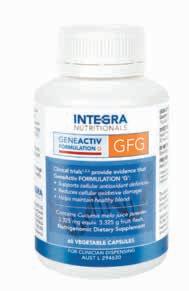

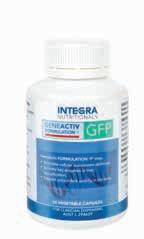


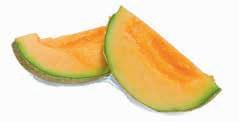









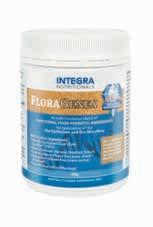
Mechanism-based Formulations Developed by Nature, Validated by Science.


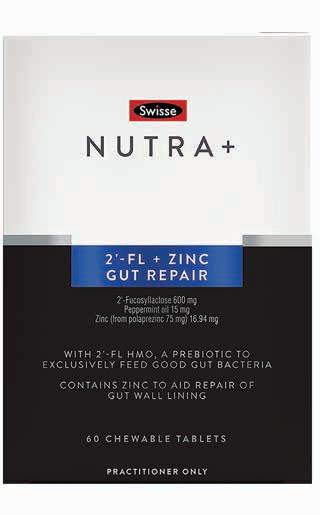


SAVE 40% WITH
2’-FL prebiotic exclusively feeds beneficial gut bacteria while zinc L-carnosine promotes GI integrity 1,2
Gut-directed hypnotherapy has been clinically demonstrated to work just as well as the low FODMAP diet, without food restriction3
